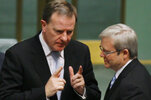JohnDe
La dolce vita
- Joined
- 11 March 2020
- Posts
- 4,335
- Reactions
- 6,397
Yay team! While there is the parliamentary process of passing legislation it appears the political process is now commencing which will involve some down-in-the dirt bare knuckle fighting (metaphorically) which will either shape the policy or kill it.
None of this is new, I'm sure that you remember that Rudd wanted to pay for the NBN by using the Future Fund.
From what I can see, it is only the left leaners and socialists wanting to raid the Future Fund, and any other pool of funds they see as fair game.
Rudd proposed selling $2.7 billion, to help with the cost of the NBN, then expected to cost $4.7 billion. as Labor looked ascendant against John Howard in 2007, opposition leader Rudd announced plans to tap the fund for money-making infrastructure projects.
“Like bears to a honey-pot, the leader of the opposition and the shadow treasurer want to drain the Future Fund of its earnings to spend on their election prospects. It is not theirs to take,” Peter Costello said.
Just before the 2007 election, the Coalition changed the law to introduce new protections to stop ministers from directing investments in particular businesses or activities. The amendments effectively Rudd-proofed the fund.
Labor eventually ditched its plan to use the fund. The NBN has gone on to cost more than $32 billion.
‘Like bears to a honey-pot’: how the Future Fund got political
Treasurer Jim Chalmers’ planned changes to the nation’s $230 billion savings account might be unfinished business for Labor.
When Kevin Rudd and Wayne Swan proposed tapping into the Future Fund to pay for the national broadband network in 2007, Peter Costello accused the pair of stealing from the future.
“The first burglary is the hard one,” the then treasurer warned. “Once you have done the first burglary, the second and the third and the fourth get much easier.”
Peter Costello accused Kevin Rudd of wanting to drain the Future Fund’s earnings for election promises. Andrew Meares
Set up in 2006, Costello considers the $230 billion savings account as one of his signature achievements – mentioning it more than a dozen times in his memoir.
Nearly two decades later, Treasurer Jim Chalmers this week directed the Future Fund to prioritise investments in housing, renewable energy and infrastructure, calling them “national priorities”.
The Coalition quickly labelled the plan reckless.
Funded with surpluses from the resources boom of the early 2000s, the Howard government added funds from the Telstra privatisation, locking away money to pay for public service superannuation entitlements.
Costello’s intention was the $60 billion in savings would meet the unfunded liabilities by 2020 – expected to be worth $140 billion.
From the very start, Costello counselled against political interference and any move to spend its savings.
“No further contributions would be required,” he wrote in 2008. “From 2020 no payments from consolidated revenue would be required. Future generations would be relieved of that cost in its entirety.”
But as Labor looked ascendant against John Howard in 2007, opposition leader Rudd announced plans to tap the fund for money-making infrastructure projects.
Rudd proposed selling the remaining Telstra shares, worth $2.7 billion, to help with the cost of the NBN, then expected to cost $4.7 billion.
“We will not do anything which will stop us from meeting our target of public servant superannuation liabilities being fully funded by 2020,” shadow treasurer Swan said at the time.
Costello was unconvinced.
“Like bears to a honey-pot, the leader of the opposition and the shadow treasurer want to drain the Future Fund of its earnings to spend on their election prospects. It is not theirs to take,” he said.
Just before the 2007 election, the Coalition changed the law to introduce new protections to stop ministers from directing investments in particular businesses or activities. The amendments effectively Rudd-proofed the fund.
Labor eventually ditched its plan to use the fund. The NBN has gone on to cost more than $32 billion.
In 2014, Qantas shareholder activist Mark Carnegie called on the Abbott government to use the Future Fund to price any debt guarantee for the struggling airline.
He told The Australian Financial Review the fund could correctly price the market rate for the government, and do so at arms’ length.
At the fund’s official launch, Costello, then seen as Howard’s likely heir and a possible future prime minister, said he had given the directors the title “guardians” very deliberately.
“It is the board’s role to guard these assets against any attempt to steal them from future taxpayers and it is their role to protect the fund against future governments of any political persuasion which might try to use or appropriate them for their own purposes.”
Businessman David Murray was appointed as the first chairman, a position later held by Costello himself. He was succeeded by former Labor minister Greg Combet earlier this year.
In January, Murray pushed back on critics of the fund and warned against it becoming “a tempting target for politicisation”. He named checked economist Dimitri Burshtein, who advocates selling the fund’s assets to pay down government debt.
If the first burglary really is the hardest, Chalmers might just be coming for Peter Costello’s legacy.
Future Fund CEO’s great fear has arrived at his doorstep
For the past few years, Raphael Arndt has warned about the dangers posed to investors by government intervention. Now he’s getting real-life experience.



